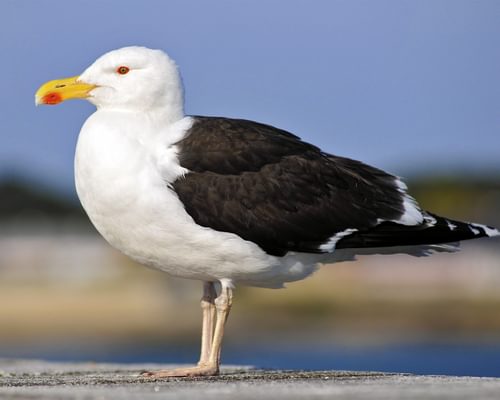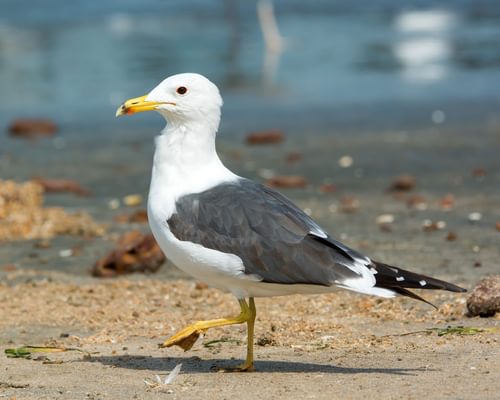American Herring Gull
Least ConcernLarus smithsonianus
Visual Identification
Appearance
The American Herring Gull is a large, robust seabird with a distinctive white head and body, pale gray back and wings, and black wingtips. Its yellow bill features a red spot on the lower mandible, and it has pink legs.
Juveniles display mottled brown plumage, gradually transitioning to adult coloration over four years. Winter adults may show faint brown streaking on the head.
Size
Length
53cm to 65cm
Wingspan
120cm to 150cm
Weight
600g to 1.65kg
Colours
Males and females have similar plumage
Primary Colour
White Grey
Secondary Colour
Black
Beak Colour
Yellow
Leg Colour
Pink
Habitat and Distribution
Habitats
Woodland
Garden
Wetland
Coastal
Urban
Farmland
Grassland
Desert
Tundra
Rainforest
Mountain
Savanna
Distribution
American Herring Gulls are primarily found along the Atlantic coast of North America, from the Arctic to Florida. They also inhabit the Great Lakes region and parts of the Pacific Northwest.
During the breeding season, they prefer coastal areas and islands. In winter, many birds move south, with some remaining in northern regions where open water persists. They are common in urban areas near water bodies in the USA and Canada.
Elevation Range
Sea level to 2,000 meters
Climate zones
Temperate, Subarctic
Distribution Map
This map gives you a rough idea of where you might spot a American Herring Gull. The coloured areas show countries where these birds have been seen.
A few things to keep in mind:
- Birds might not be everywhere in the coloured areas, for example, they may be present around the coast of that country
- Where birds live can change with seasons and available food
- This map is quite simple - it doesn't show exact locations
We're working on making our maps even better! Soon, we hope to show you:
- More detailed maps for bigger countries, including state and region
- How birds move around during different seasons
Distribution by Region
Behaviour and Ecology
Bird Attributes
This feature is in beta. We'd love your feedback to improve it!
Share your thoughtsBird Attributes Explained
Our bird attributes system rates various aspects of a bird's capabilities on a scale of 0-100, based on data from field observations, scientific studies, and expert knowledge.
Attribute Categories:
- Agility: Manoeuvrability, speed, and grace in flight or movement.
- Strength: Physical power, often correlating with size and hunting abilities.
- Adaptability: Ability to thrive in various environments or changing conditions.
- Aggressiveness: Territorial behaviour and assertiveness, particularly during breeding seasons.
- Endurance: Stamina, often seen in migration patterns or foraging behaviours.
Understanding the Ratings:
- 0-20: Very Low
- 21-40: Low
- 41-60: Average
- 61-80: High
- 81-100: Very High
Remember, these attributes are relative to other bird species and don't necessarily indicate superiority.
Hover over the icon next to each attribute for more information.
Tap the icon next to each attribute for more information.
Agility
Reflects the bird's manoeuvrability, speed, and grace in flight or movement.
Excellent aerial manoeuvrability and precision, particularly demonstrated in their ability to catch prey in mid-flight and perform complex landing manoeuvres. Their skill in dropping shellfish from heights to crack them open shows remarkable coordination.
Strength
Indicates the bird's physical power, often correlating with size and hunting abilities.
Robust build with significant wingspan (120-150cm) and substantial body mass (600-1650g). Capable of carrying relatively heavy prey items and defending territory against similar-sized birds, though not as powerful as many raptors.
Adaptability
Represents the bird's ability to thrive in various environments or changing conditions.
Remarkably adaptable species, thriving in diverse environments from urban areas to remote coastlines. Their ability to process both fresh and salt water, coupled with opportunistic feeding habits and tool use for cracking shells, demonstrates exceptional adaptability.
Aggressiveness
Measures the bird's territorial behaviour and assertiveness, particularly during breeding seasons.
Shows considerable aggressive behaviour, particularly in food acquisition and territory defence. Known to steal food from other birds and small mammals, and vigorously defend nesting sites. However, also demonstrates complex social behaviours within their own species.
Endurance
Reflects the bird's stamina, often seen in migration patterns or foraging behaviours.
Impressive stamina evidenced by their long-distance migration capabilities, ability to remain airborne for extended periods whilst foraging, and long lifespan (20-30 years, with records up to 49 years). Regular long-distance flights between feeding and nesting grounds showcase their endurance.
Diet
American Herring Gulls have a varied diet, including fish, mollusks, crustaceans, and insects. They also consume carrion and human food waste.
These adaptable birds are known to steal food from other birds and even small mammals, showcasing their opportunistic feeding strategy.
Behaviour
American Herring Gulls are opportunistic feeders, often seen following fishing boats or scavenging in urban areas. They exhibit complex social behaviors, including elaborate courtship displays and communal roosting.
These gulls are known for their ability to drop hard-shelled prey from heights to crack them open.
Vocalisation
The American Herring Gull has a diverse vocal repertoire. Their most recognizable call is a loud, laughing 'ha-ha-ha' or 'kyow-kyow-kyow'.
They also produce a variety of mewing, yelping, and long-calling sounds, especially during breeding season and territorial disputes.
Nesting & Breeding
American Herring Gulls form monogamous pairs and breed annually. The breeding season typically begins in April or May, with courtship involving elaborate displays and vocalizations.
Nests are built on the ground in colonies, often on rocky shores or islands. They construct a shallow scrape lined with vegetation, feathers, and debris. Females lay 2-3 olive-colored eggs with dark splotches.
Both parents incubate the eggs for about 28 days. Chicks fledge at 6-7 weeks but may remain dependent on their parents for several more weeks.
Lifespan
years
The American Herring Gull typically lives for 20 to 30 years.
Like all birds, lifespan can be affected by factors including predation, habitat quality, disease, and access to food sources.
Conservation and Status
Global Conservation Status
While the American Herring Gull is currently listed as Least Concern, it faces threats from habitat loss, pollution, and climate change.
Efforts to reduce plastic waste in oceans and protect coastal nesting sites are crucial for their long-term survival.
Birdwatching Tips
- Look for large gulls with pale gray backs along coastal areas and large inland water bodies
- Observe their yellow bills with red spots to distinguish them from similar species
- Listen for their loud, laughing 'ha-ha-ha' calls
- In the US and Canada, check garbage dumps and fishing ports where they often gather in large numbers
Additional Information
Quick Facts
Other names:
Smithsonian Gull, Arctic Herring Gull
Family:
LaridaePredators
Main predators include large raptors such as Bald Eagles and Great Horned Owls, as well as foxes, raccoons, and minks that target eggs and chicks.
Did You Know?
- American Herring Gulls can drink both fresh and salt water thanks to special glands that remove excess salt.
- They can live for over 30 years in the wild, with the oldest recorded individual reaching 49 years.
- These gulls are highly intelligent and have been observed using tools to crack open mollusks.
Was this bird profile helpful?
Your feedback helps us improve our content
Thanks for your feedback!
Your input helps us improve our content.
Community Experience
Community Ratings
No ratings yet - be the first to rate this bird!
Latest Community Reviews
No reviews yet
Sign in to be the first to review
Community Reviews
Create Your Free Account Welcome Back!
Join our community to rate birds and share your experiences. Creating an account is completely free and only takes a minute. Sign in to your account to rate birds and share your experiences with our community.
Your information is secure and will never be shared.
By creating an account, you agree to our Privacy Policy.
Similar Birds
References
- 1
website: BirdLife International. 2019. Larus smithsonianus (amended version of 2018 assessment). The IUCN Red List of Threatened Species 2019: e.T62030590A155596462.
View source - 2 3
report, 2014: Wetlands International

